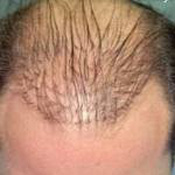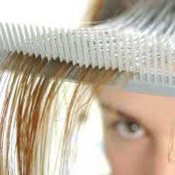!


Hair Loss
Androgenic Alopecia is the medical term for the most common form of excessive or abnormal hair loss in men and women. Temporary or permanent hair loss can be triggered by many factors such as sudden or intensive stress, hormonal dysfunctions, reaction to medications, skin diseases, wounds and infections of the scalp, insufficient nutrition, chemotherapy or radiation. Temporary hair loss can be easily treated when the cause for it is known, or very hard to deal with when the cause can’t be identified. In the majority of cases however hair loss is a natural permanent process related to aging, rather than a disease. Dihydrotestosterone (DHT), a derivative enzyme of the male hormone testosterone, is believed to be the main reason for hair loss in both men and women. It causes hair follicles to shrink and change shape, as a result producing thinner strands of hair with each hair growth cycle and slowing down hair production till they stop producing hair strands at all.
Hair loss in men may start at any moment after puberty with the rise of androgens’ blood levels. The first signs of Male Pattern Baldness are associated with hair loss in the temporal areas of the scalp. With the advance of age, the hairs tend to become shorter and thinner and begin to lose colour while the pattern gradually leaves place to a more visible baldness spreading all over the crown of the head leaving only a rim resembling a horseshoe pattern in most advanced cases. Usually by the age of thirty-five around 70 % of men experience some evident hair loss, while by the age of fifty most of them endure substantial hair loss and thinning. Advanced hair loss in men is determined by The Norwood Scale, with values advancing from 1 to 7. The temp at which men lose hair throughout their lives differs for each individual. Usually people, who go through a rapid hair loss in their younger years, experience no significant hair loss later on; while people with no evident baldness till their mid forties and fifties, endure major hair loss for a very short period of time. Most men are genetically predisposed to male pattern baldness. In women, however, hair loss can be a result of multiple factors and circumstances.
Hair loss in women is not similar to male pattern baldness. Unlike men, women suffering from hair loss usually do not lose their frontal hairline and are more worried about losing hair volume from the top and back of the head. By women the affected areas are distributed more regularly over the scalp, including the sides and back, making any loss of hair less noticeable. The most common pattern of women’s hair loss is the diffuse alopecia, i.e. an overall thinning in all areas of the head, most evident on the crown usually developed in their mid thirties. Sometimes limited baldness may be visible on the vertex (the top of the head). Female Pattern Baldness is linked to the menstrual cycle and is most likely to emerge during periods of hormonal changes when estrogen levels decrease such as usage of birth control pills, during pregnancy and after delivery or prior to and during the menopause period. Normally three to six months upon giving birth to a child, women may experience some temporary hair loss which lasts about a year. Female Pattern Baldness is assessed by the Ludwig Scale with stages progressing from 1 to 4.
Both for men and in women, hair loss can be truly emotionally distressing experience and people suffering from it may become quite vulnerable. It affects every aspect of people’s life, including physical and psychological condition, interpersonal relationships as well as individual’s professional career. Hair loss can have a crucial negative impact on the sufferer’s self image leading quite often to an emotional break-down. Sufferers spend billions of dollars each year for hair loss treatment products that prove to be inefficient for the mass of the people who use them.
